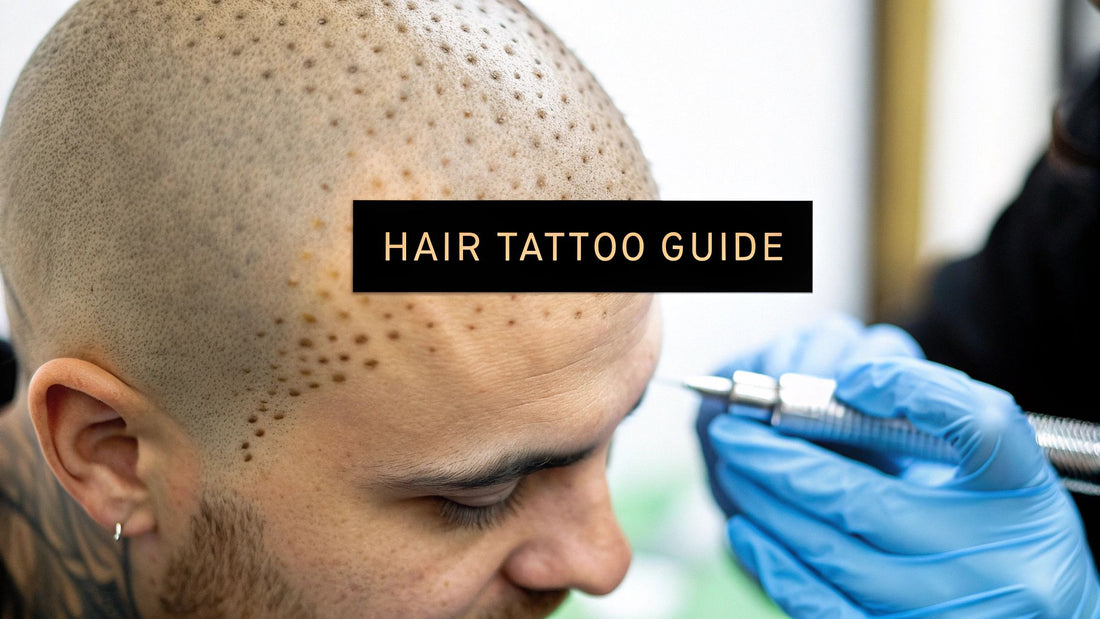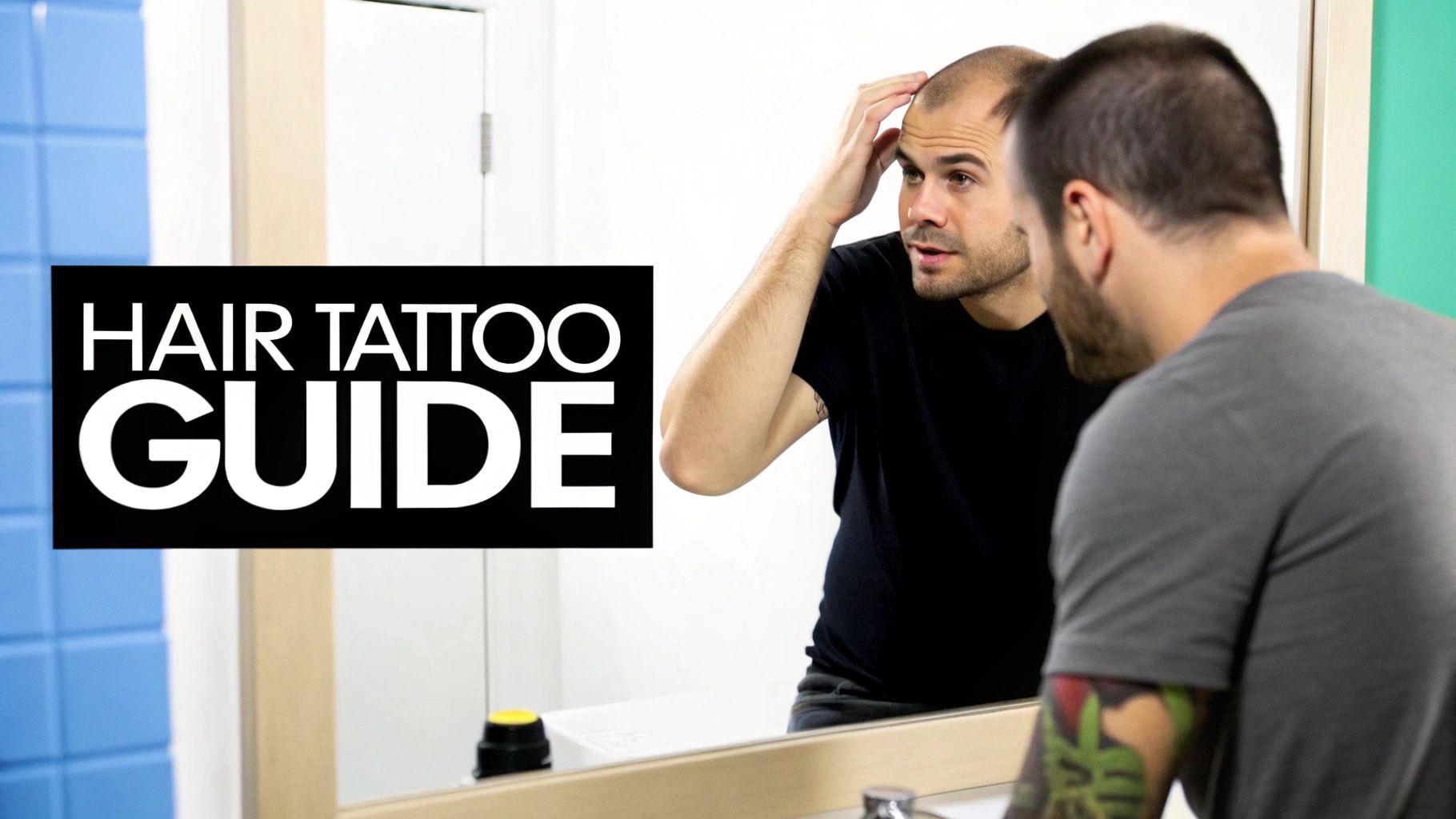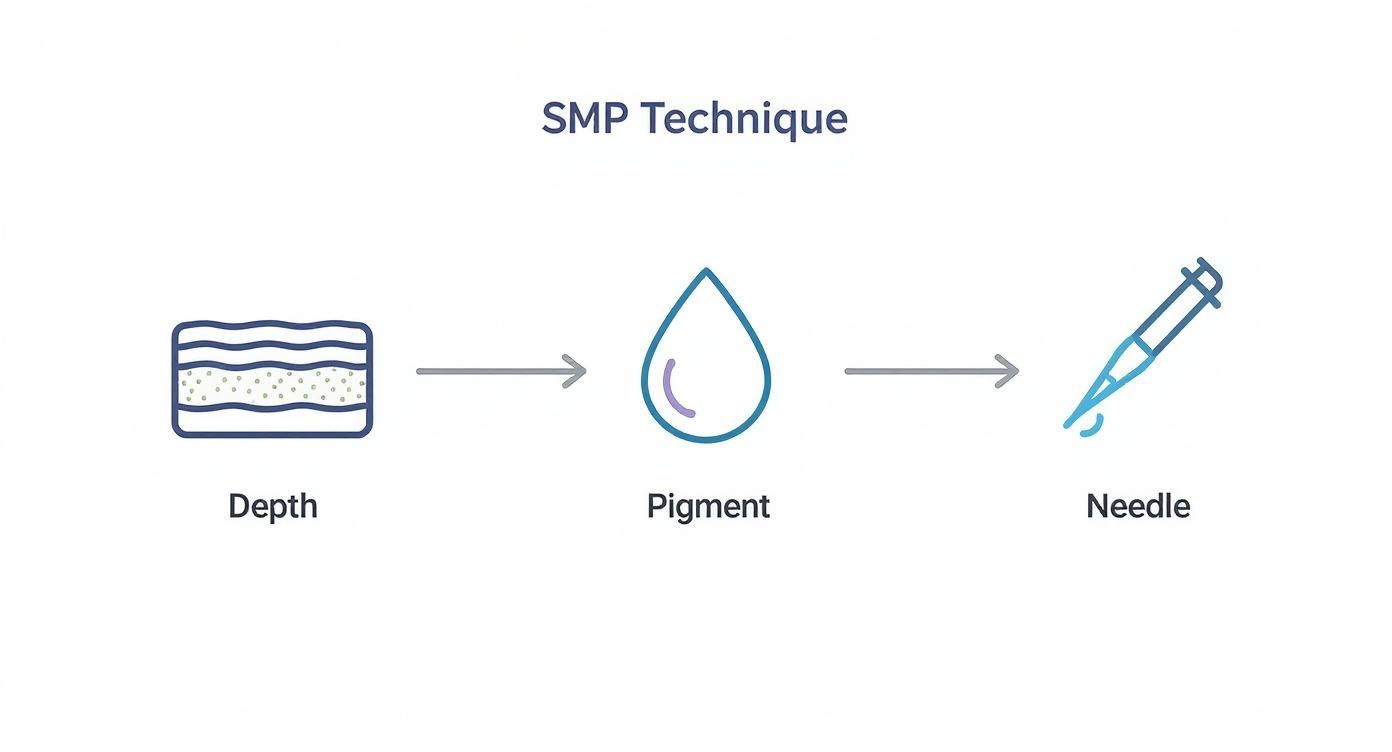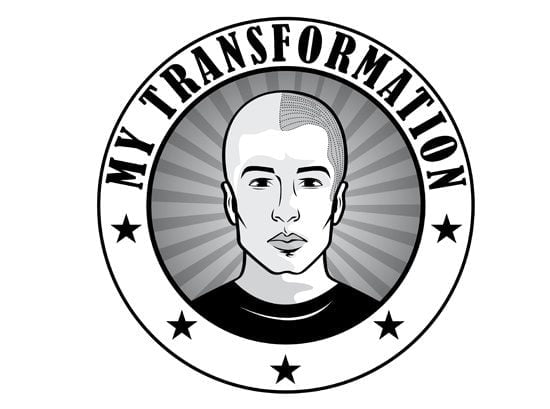
Hair Tattoo for Baldness A Complete Guide
Share
Let's be honest, watching your hairline recede or your crown thin out can be a real knock to your confidence. But what if there was a way to get the look of a full head of hair without surgery? That's where the hair tattoo for baldness, or Scalp Micropigmentation (SMP), comes in. It’s a game-changing cosmetic treatment that masterfully creates the look of a sharp buzz cut or adds density to thinning hair.
What Is a Hair Tattoo and How Can It Help?

You’ve probably heard the term 'hair tattoo' and wondered what it's all about. It’s a catchy name for a highly specialised procedure called Scalp Micropigmentation (SMP). Forget everything you know about traditional tattoos; this is a completely different ball game.
Think of it more like an intricate art form. A trained SMP artist uses ultra-fine microneedles to deposit thousands of tiny pigment dots into the upper layer of your scalp. Each dot is carefully placed to mimic the look of an individual hair follicle, creating a perfectly blended and natural-looking result.
The Goal of Scalp Micropigmentation
The end game here is to create a believable illusion of hair density. For guys who are completely bald or have a receding hairline, SMP can expertly recreate a sharp, full hairline that looks like a fresh buzz cut. If you're dealing with thinning hair, the pigment fills in the gaps, which minimises the contrast between your scalp and hair, making what you have look much thicker and fuller.
It's a standout solution because it's:
- Non-Surgical: No incisions, no scars, and no long, painful recovery like you’d get with a hair transplant.
- Immediately Effective: You walk out of your very first session with a visible difference. The final look is usually perfected over two to three sessions.
- Low Maintenance: After your treatment is complete, you can say goodbye to daily routines. Just some basic skin care and sun protection is all you need.
Who Benefits from This Treatment?
Hair loss is far from a rare problem. In fact, over 50% of Australian men will deal with some form of it, and genetics mean that about one in seven will experience it more aggressively. The search for a solid solution is a big deal for a lot of guys. SMP offers a practical, stylish way to camouflage baldness and thinning without going under the knife. For more on local hair loss statistics, you can check out the breakdown from Hairskeen Australia.
This guide is here to cut through the jargon and give you the straight-up facts. We’ll walk you through how SMP works, its benefits, the costs involved, and what you need to do to look after it, giving you a clear picture of how you can reclaim your confidence.
How a Hair Tattoo Actually Works
Calling Scalp Micropigmentation (SMP) a "hair tattoo" is a good start, but it doesn't quite capture the whole picture. It's a bit like calling a high-performance race car just another car. Yes, both involve needles and pigment, but that’s where the similarities end. SMP is a highly specialised field where artistry meets precision, all designed for one single goal: to perfectly mimic the look of natural hair follicles.
The whole process is far more delicate than a regular tattoo. Instead of the heavy-handed approach used for body art, SMP technicians use custom-built equipment with microneedles. These needles are incredibly fine and only just break the surface of the skin, depositing pigment into the upper layer of the dermis. This shallow depth is the secret to creating the crisp, defined dots that look just like real hair.
Think of it less like drawing and more like pointillism. You know, where an artist creates a detailed image using thousands of tiny, perfectly placed dots? That’s exactly what an SMP practitioner does on your scalp.
The Tools and Pigments of the Trade
The equipment used for SMP is purpose-built for the job. The machine cycles the needles at an incredibly high rate, placing a tiny droplet of pigment with each entry. This controlled method is vital—it stops the pigment from spreading under the skin, which would just create a blurry mess.
The pigments are also completely different from standard tattoo inks. Here’s what sets them apart:
- Composition: SMP uses a special carbon-based pigment. It's designed to hold its shape and colour without breaking down over time.
- Colour Stability: Regular tattoo inks can often fade to an unwanted blue or green shade over the years. SMP pigments are different; they're formulated to simply lighten gradually over a long period, always staying within a natural grey-scale tone.
- Customisation: Before starting, the pigment is carefully mixed for every single client. This ensures it perfectly matches your remaining hair and skin tone for a completely seamless result.
This meticulous process is what prevents that dreaded "painted on" or "helmet" look. A skilled technician will actually use slightly different shades and dot sizes across your scalp to create a subtle, multi-tonal effect, just like a real head of hair.
A common worry is that the result will look like a solid block of colour. The real artistry of SMP is in the layering. Over several sessions, the practitioner builds up the density bit by bit, creating a soft, textured appearance that looks like a sharp buzz cut, not a hat.
The Art of a Natural-Looking Result
Getting a hyper-realistic finish is a true art form. It requires a solid understanding of how hair grows and what looks right for a person's face. The practitioner isn't just colouring in bald patches; they're carefully crafting a new frame for your face.
This involves a few key artistic steps:
- Hairline Design: The initial chat is where it all begins. Your technician will work with you to map out a hairline that looks right for your age and face shape. They’ll steer clear of unnaturally sharp or low hairlines, aiming instead for a softer, more natural appearance that complements your features.
- Building Density: The first session is all about laying the groundwork. The next few sessions are for adding more layers of dots, which creates that fantastic illusion of density and depth. This careful layering is what makes the difference between an average result and a great one.
- Seamless Blending: For anyone just dealing with thinning hair, the technician’s job is to skilfully blend the tiny dots in with your existing hair. The idea is to close the gap in colour between your scalp and your hair, which makes thin areas look much fuller.
Ultimately, the whole thing is a partnership between technical skill and artistic vision. By understanding how SMP works to replicate hair loss, you can see it’s so much more than a tattoo—it's a sophisticated treatment designed to bring back the look of a full head of hair with incredible detail and care.
Your Complete SMP Journey From Start to Finish
Deciding to get Scalp Micropigmentation (SMP) isn't about a single appointment; it's a carefully planned journey. Understanding what happens at each stage, from your first chat with a specialist to seeing the final result, is key. This isn't a rush job—it's a multi-step process designed for a perfectly realistic finish.
It all kicks off with a thorough consultation. Honestly, this is probably the most crucial part of the whole thing, as it lays the groundwork for everything that follows. Think of it as a strategy session where you and your technician team up.
Stage One: The Initial Consultation
This is where we sit down and talk about your hair loss journey and what you’re hoping to achieve. Your technician will take a close look at your level of baldness, your skin type, and any hair you have left to map out a truly custom plan.
The real artistry starts here. You'll work together to design a hairline that looks right for you—something that suits your face shape, age, and personal style. We aim for a soft, natural frame for your face, steering clear of those hard, unnaturally low hairlines you sometimes see. We'll also custom-blend pigment shades to get an exact match for your remaining hair and skin tone.
For a closer look at what this first meeting entails, you can explore our detailed guide on what the process of getting a hair tattoo looks like.
Stage Two: The Foundational First Session
Your first treatment is all about laying the foundation. Once the hairline design is locked in, the technician gets to work, applying the first layer of tiny pigment dots across the scalp. This session usually takes anywhere from two to four hours, depending on how much area we need to cover.
Think of it like applying the first coat of paint. It won't look finished just yet, but you'll immediately notice less contrast between your scalp and hair. This creates a subtle shadow effect that's a huge first step. Afterwards, you'll get some strict aftercare rules to make sure the pigment settles in perfectly.
The infographic below shows the precise technique we use in every session, giving you a better idea of how needle depth and pigment application work together.

This really highlights how SMP artists manage depth, pigment, and needle precision to perfectly mimic the look of natural hair follicles.
Stage Three: Building Density And Depth
After about a week of healing, you’ll come back for your second session. This is where the magic really starts to happen. Your technician will build on that initial foundation, adding more layers of pigment to create that amazing illusion of dense, three-dimensional hair.
Slightly different shades and dot sizes are used to copy the natural, subtle variations you see in a real head of hair. This careful, layered approach is what makes the difference between an average result and a truly undetectable hair tattoo for baldness. Sometimes, a third session is needed a few weeks later for those final, perfecting touches.
The multi-session approach is non-negotiable for a quality outcome. Rushing the process by trying to add too much density in one go would result in a flat, unnatural "helmet" look rather than the subtle, textured appearance of a real buzz cut.
Here in Australia, SMP has become incredibly popular, mainly because it's non-invasive and the results are instant. It works for every stage of hair loss, from a slightly receding hairline to complete baldness, and the custom pigment application ensures it looks just like your own hair follicles. It’s a journey that delivers a natural-looking result that can last for years with very little upkeep.
Is Scalp Micropigmentation Right for You?
Scalp micropigmentation can be an incredible, life-changing solution for hair loss, but it's important to know that it isn't a silver bullet for everyone. Making the right choice means taking an honest look at your hair loss, your goals, and even your skin type. This is more than just getting a hair tattoo for baldness; it's about finding a long-term cosmetic fix that genuinely suits you and your lifestyle.
The best candidates for SMP are often those who are ready to fully embrace a sharp, clean-shaven style. It’s a fantastic match for anyone who has come to terms with their hair loss and wants a modern, low-maintenance look that perfectly frames their face and brings back a strong, defined hairline.
The Ideal Candidates for SMP
Some hair loss situations are practically made for SMP. If you find yourself nodding along to any of the descriptions below, this treatment could be a brilliant move for you.
-
Men Embracing the Buzz Cut: This is the classic SMP success story. For guys dealing with male pattern baldness—whether it's a receding hairline or thinning at the crown—SMP flawlessly replicates the appearance of a full head of hair kept in a permanent, sharp buzz cut. It looks stylish, masculine, and is completely fuss-free.
-
Adding Density to Thinning Hair: You don't have to be completely bald to see amazing results. SMP works wonders for both men and women who are experiencing diffuse thinning all over. By carefully placing pigment between existing hairs, the treatment instantly reduces the harsh contrast between your hair and scalp, creating a convincing illusion of much thicker, denser hair.
-
Camouflaging Scars: SMP is a game-changer for hiding scars. Whether you have scars from hair transplant surgeries (both FUT and FUE), an old accident, or another injury, a skilled artist can meticulously blend pigment into the scar tissue. This makes the scar blend seamlessly with the surrounding 'hair', making it far less obvious. To learn more, check out our detailed article on who can benefit from hair tattoos.
When to Approach with Caution
While SMP is incredibly versatile, it simply isn't the right path for everyone. Any reputable practitioner will be upfront about the treatment's limitations and will turn you away if you're not a suitable candidate. It's vital to understand the conditions or expectations that could make SMP less effective or potentially risky.
For instance, anyone with an active, severe scalp condition needs to wait until their skin has fully healed. Trying to apply pigment to an inflamed or irritated scalp is a recipe for poor results and can lead to complications down the line.
Crucial Takeaway: Honesty during your consultation is everything. A great SMP artist always puts your safety and long-term happiness first—it's not just about getting you in the chair. They will properly assess your scalp health and talk you through any potential issues.
Here’s a quick guide to help you figure out where you stand.
Scalp Micropigmentation Suitability Checklist
This table breaks down scenarios where SMP is a great fit versus situations where you should think carefully or explore other options.
| Scenario or Hair Loss Type | SMP Suitability | Key Considerations |
|---|---|---|
| Male Pattern Baldness | Excellent | Perfect for creating a clean buzz-cut look. You must be comfortable with maintaining a shaved head. |
| Diffuse Hair Thinning | Very Good | Effectively adds the illusion of density by reducing scalp visibility. Works best with darker hair colours. |
| Hair Transplant Scars | Excellent | Superb for camouflaging both FUT (strip) and FUE (dot) scars, making them blend in. |
| Alopecia Areata | Good (with caution) | Can be effective, but treatment should only be done when the condition is stable and not in an active phase. |
| Active Scalp Conditions | Not Suitable | Conditions like severe psoriasis, eczema, or folliculitis must be resolved before treatment can begin. |
| Keloid Scarring Prone | Not Recommended | The micro-wounds from the needle can trigger keloid formation, so it's generally too risky. |
| Desire for Hair Length/Texture | Not Suitable | SMP is a 2D illusion. It won't feel like real hair or provide any length. |
Ultimately, a good consultation will clear up any doubts. Here are a few specific situations where you should definitely pause and think twice:
- Active Scalp Conditions: If you're dealing with a bad flare-up of psoriasis, eczema, or folliculitis on your scalp, the treatment simply can't go ahead. The inflammation and unstable skin will stop the pigment from settling properly.
- Keloid Scarring Tendencies: If your skin is prone to developing keloid scars (the thick, raised, overgrown type), you are generally not a good candidate. The tiny needles still create micro-wounds, and for you, that could trigger a keloid response.
- Unrealistic Expectations: It’s important to remember that SMP creates the illusion of hair follicles. It won’t make your hair grow back, and it won’t feel like real hair to the touch. If you're really hoping for a solution that adds texture or length, it might be worth exploring other avenues.
Breaking Down the Cost of a Hair Tattoo
So, let's talk numbers. Understanding what you'll likely invest in a hair tattoo for baldness is a crucial step. This isn't like buying something off a shelf with a fixed price tag. Think of it more like commissioning a piece of art for your scalp—the final cost really comes down to the detail and scope of the work.
Every client is different, so the price is tailored to match. The biggest factor, by far, is the extent of your hair loss. We often use the Norwood scale to measure this, which is just a formal way of classifying the different stages of male pattern baldness. It makes sense, right? Someone just touching up a slightly receding hairline will need far less work than someone with significant hair loss across their entire head.
Key Factors That Influence Pricing
Your final quote is really a reflection of the artist's time, their level of skill, and the amount of pigment needed to create that perfectly blended, natural-looking result.
Here’s a quick look at what technicians consider when drawing up a quote:
- Area of Coverage: This is the most straightforward factor. A larger bald or thinning area simply takes more time and resources to treat. A full scalp treatment for someone at a Norwood 6-7 stage is the most comprehensive job.
- Desired Density: Are you after a soft, subtle fill to add the illusion of thickness, or do you want a sharper, more defined buzz-cut look? Achieving that denser appearance requires more pigment impressions and more time in the chair.
- Scar Camouflage: Working over scar tissue—whether from an old injury or a past hair transplant—is a specialised skill. Scar tissue behaves differently, so it takes a more delicate touch and advanced techniques to make sure the pigment blends in seamlessly.
It’s helpful to see SMP as a long-term investment in your confidence. When you weigh the one-off cost against the ongoing expenses of hair systems, messy topical treatments, or the hefty price tag and unpredictable results of surgery, SMP often comes out as the most sensible financial choice over the years.
Realistic Price Ranges in Australia
To give you a ballpark idea, SMP costs in Australia are usually tiered according to the level of hair loss. For example, a minor touch-up, like refining a hairline, might fall somewhere between AUD 500 to AUD 1,200.
For those with more noticeable thinning, the price generally sits between AUD 1,200 to AUD 2,400. More advanced, widespread hair loss can range from AUD 2,400 up to AUD 3,400. The longevity of the treatment really makes this initial outlay a worthwhile investment.
Of course, the clinic’s reputation and the artist's experience will also play a role in the price. It can be tempting to go for the cheapest quote you can find, but remember, this is a highly technical procedure being performed on your head. Paying for a skilled, reputable artist is your best bet for getting a result that looks genuinely natural and stands the test of time. For a deeper dive, we've created a comprehensive guide that breaks down every element of the hair tattoo cost to help you plan your budget.
Long-Term Care for Your Hair Tattoo

You’ve made a great investment in your appearance and confidence with a hair tattoo for baldness, and looking after it is surprisingly simple. Think of it like a quality tattoo or a fine piece of art—a few easy habits will keep it looking crisp and fresh for the long haul.
The first few days after each session are the most important. This is when the pigment is settling into the top layer of your skin, and you want to give it the best possible chance to heal perfectly. Your practitioner will provide a detailed aftercare plan, but the main principles are always the same.
For the first three to four days, it’s crucial to keep your scalp completely dry. That means no washing, avoiding intense gym sessions that make you sweat, and staying out of pools and saunas. The goal is to let those tiny pigment dots heal without any disturbance. It’s the secret to a sharp, defined result that lasts.
Your Immediate Aftercare Checklist
Getting the initial healing right is non-negotiable. Follow these steps meticulously after your treatment to ensure the pigment sets perfectly.
- Avoid Water and Sweat: For at least four days, keep your scalp dry. This allows the micro-wounds to close up properly and lock in the pigment.
- Steer Clear of the Sun: Fresh pigment is vulnerable to UV rays. If you have to be outside, wear a hat to shield your scalp.
- Do Not Touch or Scratch: Your scalp might get a little itchy as it heals, which is normal. But you absolutely must resist the urge to scratch or pick at it.
- Postpone Shaving: Hold off on shaving your head for at least five to seven days. Shaving too soon can irritate the sensitive skin and disrupt the healing process.
Building Long-Term Maintenance Habits
Once you’re past that initial healing window, maintaining your SMP is incredibly low-maintenance. It all comes down to one golden rule: protect your scalp from the sun. UV radiation is the biggest enemy of any pigment, causing it to fade prematurely.
Making sun protection a daily ritual is the single most effective thing you can do for your hair tattoo.
Think of sunscreen as your SMP insurance policy. Just like UV rays can make a regular tattoo fade and blur, they'll do the same to your scalp micropigmentation. Consistent sun protection is what keeps it looking sharp for years.
Get into the habit of applying a high-SPF sunscreen (SPF 30+ or higher) to your scalp every single day, even on cloudy ones. If you plan on being outdoors for a while, a hat provides an extra, powerful layer of defence against the sun.
Keeping your scalp moisturised is also a game-changer. Healthy, hydrated skin holds pigment better and looks fresher. A simple, non-comedogenic moisturiser applied daily will prevent dryness and flaking, ensuring your SMP always looks its best. For a deeper dive, check out our top tips to care for your scalp after SMP.
Planning for Future Touch-Ups
Even with the best care in the world, your hair tattoo will gradually and naturally lighten over time. This is completely normal. Most clients find they’re ready for a touch-up session every four to six years to restore the original colour and density.
A touch-up is usually a quick, single-session appointment to bring everything back to life. By following these straightforward long-term care steps, you’ll make sure your investment continues paying off with a sharp, confident look for years to come.
Got a Few More Questions About Hair Tattoos?
It's completely normal to have a few questions still buzzing around in your head, even after getting a good overview. Deciding on a hair tattoo for baldness is a big step, and you should feel 100% confident before moving forward. So, let’s clear up those common queries right now.
Think of this as the final piece of the puzzle. We'll cover everything from what it feels like to how it looks as the years go by, making sure you have all the answers you need.
Does Getting a Hair Tattoo Hurt?
This is probably the number one question on everyone's mind, and the answer usually comes as a relief. Most people say it feels more like a minor annoyance or a light scratching sensation, not real pain. On a scale of one to ten, the discomfort generally lands somewhere between a 2 and a 4.
It’s definitely much less intense than getting a traditional tattoo. The reason is simple: the very fine, specialised needles for scalp micropigmentation only work on the upper layers of your skin, unlike the deeper penetration of a standard tattoo needle. Plus, your technician will almost always apply a topical numbing agent to your scalp before they start, just to keep you comfortable. Some spots, like around the temples or the front hairline, can be a little more sensitive, but it's very manageable.
How Long Does a Hair Tattoo Last?
When done properly by a professional, SMP is a lasting solution. You can expect your results to look crisp and clear for 4 to 8 years—sometimes even longer—before you might think about a touch-up. How long it lasts really comes down to a few things.
The biggest factor is your lifestyle, especially how much sun your scalp gets. Protecting your head from the sun is the golden rule for making your pigment last. Your immune system and skin type also have a role to play. After many years, the pigment will naturally lighten in a soft, even way. When that happens, a quick touch-up session is all it takes to bring back that original depth and colour.
The longevity of your SMP is largely in your hands. Treating your scalp with care, especially by using a high-SPF sunscreen, is the single best thing you can do to protect your investment and keep it looking its best for years.
Will People Know It Is a Tattoo?
Honestly, when your hair tattoo is done by a skilled artist, it should be virtually undetectable. The whole point is to create a hyper-realistic illusion of hair that blends perfectly with your scalp, facial features, and any hair you still have.
So, how do the pros make it look so real?
- Custom Pigment Blending: The artist won't just use black ink. They carefully mix shades to get an exact match for your natural hair colour and skin tone.
- Realistic Follicle Replication: Using different needle sizes and depths, they perfectly mimic the look of individual hair follicles, which are never all the same size.
- Soft Hairline Design: A great artist avoids sharp, unnatural lines. They'll design a soft, slightly broken hairline that’s age-appropriate and suits your face shape.
From a normal, everyday distance, it’s almost impossible for anyone to tell it isn't your own hair shaved down to a sharp buzz cut. The magic is all in those tiny details.
What if My Remaining Hair Turns Grey?
That’s a brilliant question, and it's something every good SMP artist plans for from the very beginning. The pigments used aren't a solid, heavy black. They are actually charcoal or grey-based and are diluted to create the perfect shade for you.
This means that as your natural hair starts to go grey or white, it blends seamlessly with the SMP work underneath. The tattooed follicles keep giving you that look of density, while your greying hair adds a natural "salt and pepper" texture on top. Because the pigment is also designed to soften over many years, it will never look harsh or out of place against your greying hair.
At My Transformation, we are dedicated to helping you find the perfect solution for your hair loss. Michael’s passion is to provide results that restore not just the look of your hair, but your confidence too. If you’re ready to explore how scalp micropigmentation can work for you, we invite you to learn more and book a consultation.
Discover your transformation at https://www.mytransformation.com.au.
